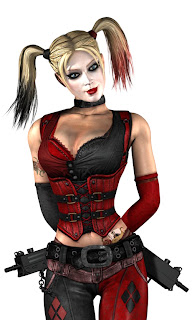Vigilante of Gotham becomes Savior of Arkham City
Before Arkham City is even mentioned, I believe that it is important to examine the character of Batman and his potential as a video game character. Batman is notorious for being matched up against and with super heroes, but not being "super" or really even a true "hero". Simply put, he is a well-trained, well-equipped vigilante that parades around in a bat mask, but in reality, Batman represents much more than that. He has experienced trauma on a deep level; he responds to this by bashing in the brains of any evildoer that he finds and by brooding a lot. In the ranking of fictional characters, Batman would be most likely be labeled as an "elite badass" (2nd only to Tyler Durden's position as "ultimate badass"). Also, Batman fights his enemies through a combination of advanced fighting skills, state-of-the-art technology, and stealth. As long as the game developers use these facets well, Batman represents the nearly ideal candidate for a video game main character.

To make a long story short, the designers of Arkham City used the character of Batman, the characters from the comics/movies, and the mechanics of the game very well. The play area is enormous, reportedly five times larger than the previous installment "Batman: Arkham Asylum". More than that, though, it authentically feels like a universe in which Batman would be the nighttime ruler. The city is ominous, dark, and best of all, open. It gives Batman the opportunity to spread his wings and soar across the skyline of the city, striking fear into the villains below. The setting is completed by the various gangs that inhabit the city. The designers took great care to make each section seem unique for each gang. For example, the area that belongs to the Joker has more silly and demented themes and artwork while the area that belongs to Two-Face is more crude. This allows the player to become further into the story behind the game.
The fighting style that the game employed was superb. There were a variety of takedowns that the player could use depending on the situation, but for the most part, it was the simplicity of the style that made it so effective. If multiple players were attacking Batman, then the player would most likely alternate between timing the attack of the "X" button and using the "Y" button, which is used for blocking the enemy's attack. Other examples of attacks that can be used within the game are a silent takedown (sneaking up on an enemy), a double takedown (sneaking up on two enemies and bashing their heads together), a ground takedown (after beating an enemy to the ground, delivering a knockout punch), and many others. The video below is a good representative of how smoothly the game's fighting sequences can flow.
The wide arsenal of characters was certainly not a detractor. Among the more prominent ones were the Joker, Dr. Hugo Strange, the Penguin, Ra's al Ghul, Catwoman, Mr. Freeze, and Bane. Some were involved in side missions while others were a large part of the main storyline. Another wonderful addition to the game were the voices of Batman and the Joker: Kevin Conroy and Mark Hamill respectively. These actors, especially Mark Hamill, helped bring a reality to the animated characters in a way that would have been difficult for anyone else.
 |
Mark Hamill, who played Luke Skywalker and provided the voice of the Joker.
Hmm... a lightsaber-wielding Joker. That's a scary thought. |
While all of these things were really cool additions to a solid game, the driving force was the main story. I specified the main story because there were a myriad of side missions within the game that involved other storylines. The main storyline begins with Dr. Hugo Strange throwing Batman into Arkham City and revealing that he knows Batman's true identity. After this, Batman is forced into fighting an array of villains before facing the Joker. Before this, the player has learned through Batman that Joker has become ill with a terminal disease. The Joker tried to cure it by using Titan formula supplied by Bane, but it only mutated the disease and made it worse. In order to enlist Batman's help, the Joker tricked Batman and gave him a bit of the Joker's blood. After that, Batman began looking for a cure so that they could both survive.
The intriguing part about this storyline is that it offered a deeper examination of the relationship between Batman and the Joker, which was already one of the most complex relationships within the comic book world. The entire story was riddled with amusing interactions between the characters, captivating developments and battles, and even a few surprising turns. By the time that the story had concluded, I was stunned by the magnitude of it, but also deeply sad that it was over. I suppose that is exactly the reaction that the game developers want.
Arkham City is one of the best all-around games that I have ever played. I am a little biased because I already have an appreciation for Batman and a preference for open-world games, but even still, it is difficult to find any kind of criticism against the game. If anything, I object against the game's depiction of women. Almost all of the women within the game are very weak characters or overly sexualized. For a strong example, see the picture below:
 |
| She must be quite toasty in all of that skin-tight clothing. |
Other than that unnecessary appeal to teenage boys, it was sincerely a privilege to play a game of this scale.





.gif)









